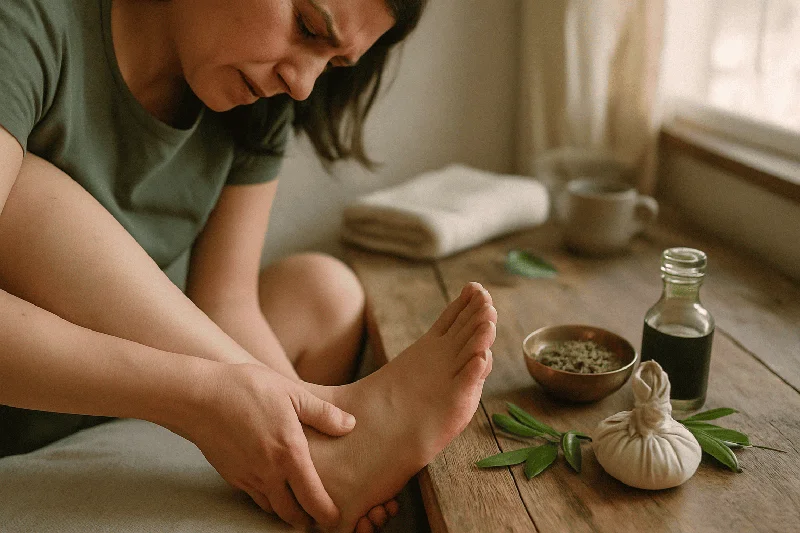Ask Ayurvedic doctor a question and get a consultation online on the problem of your concern in a free or paid mode. More than 2,000 experienced doctors work and wait for your questions on our site and help users to solve their health problems every day.
Shop Now in Our Store
Heel Pain Remedies in Ayurveda for Natural Relief

Introduction to Heel Pain Remedies in Ayurveda
Heel pain can disrupt daily activities and significantly impact quality of life. In Ayurveda, heel pain (often linked to conditions like Vatakantaka) is treated using natural methods to reduce inflammation, improve circulation, and balance the body’s doshas. By combining herbal remedies, therapies, and lifestyle changes, Ayurveda offers holistic and lasting solutions to heel pain without relying on synthetic medicines.
This article explores Ayurvedic remedies for heel pain, its causes, benefits of treatments, and frequently asked questions to help you regain comfort and mobility naturally.
Causes of Heel Pain in Ayurveda
According to Ayurveda, heel pain results from an imbalance of Vata dosha, which causes dryness, stiffness, and discomfort in the heel area. Common causes include:
-
Excess physical activity or prolonged standing
-
Wearing improper footwear
-
Obesity, leading to extra pressure on heels
-
Weak digestion causing toxin (Ama) accumulation
-
Stress, poor sleep, and lack of self-care
Addressing these root causes is key to finding lasting relief.
Key Heel Pain Remedies in Ayurveda
1. Herbal Oils and Massages
Ayurvedic massage, or Abhyanga, using medicinal oils like Mahanarayan oil or Sesame oil, can provide immediate relief by soothing muscles, reducing stiffness, and improving blood circulation.
-
How to Use: Warm the oil and gently massage the heel for 10-15 minutes twice daily.
-
Benefits: Reduces inflammation, relaxes muscles, and nourishes the tissues.
2. Pinda Sweda (Herbal Poultice)
Pinda Sweda is a unique Ayurvedic therapy where heated herbal powders and oils are applied to the affected area using a poultice.
-
How to Use: Prepare a poultice with herbs like Ashwagandha, Shatavari, and Dashamoola; apply it to the heel.
-
Benefits: Alleviates pain, reduces swelling, and promotes relaxation.
3. Herbs for Internal Healing
Herbs play a vital role in addressing the root causes of heel pain. Some essential Ayurvedic herbs include:
-
Ashwagandha: Reduces inflammation and strengthens muscles.
-
Guggulu: Acts as an anti-inflammatory and pain reliever.
-
Triphala: Helps detoxify the body, reducing Ama accumulation.
-
Shatavari: Nourishes bones and tissues.
How to Use: These herbs can be consumed as powders, decoctions, or capsules after consulting an Ayurvedic practitioner.
4. Foot Soak Therapy
Soaking the feet in warm water infused with Epsom salt, Turmeric, or Neem leaves can provide quick relief.
-
How to Use: Soak your feet for 15-20 minutes daily.
-
Benefits: Reduces stiffness, inflammation, and promotes relaxation.
5. Diet and Lifestyle Adjustments
Diet plays a crucial role in managing heel pain. Ayurveda emphasizes eating warm, easily digestible foods to balance Vata dosha.
-
Include: Soups, ghee, nuts, warm milk with turmeric.
-
Avoid: Cold foods, processed items, and excessive caffeine.
Additionally, Yoga and gentle exercises like stretching the calf muscles, using a tennis ball for self-massage, and Padahastasana (forward bend pose) can strengthen and relax the heels.
6. Basti Therapy (Vata Balancing Treatment)
Basti, a therapeutic enema using medicated oils, is highly effective for Vata-related heel pain.
-
How It Works: Helps flush toxins and balance Vata dosha.
-
Benefits: Long-term pain relief and improved joint flexibility.
7. Turmeric and Ginger Remedies
These powerful anti-inflammatory spices can be consumed internally or applied externally to alleviate heel pain.
-
How to Use: Mix turmeric paste with warm water and apply to the heel; drink ginger tea regularly.
-
Benefits: Reduces inflammation and promotes tissue repair.
Frequently Asked Questions (FAQ)
1. What causes heel pain in Ayurveda?
Heel pain is primarily caused by an imbalance of Vata dosha, poor circulation, toxin accumulation, or excess strain on the feet.
2. How can Ayurvedic oils help with heel pain?
Herbal oils like Mahanarayan and Sesame oil reduce inflammation, nourish tissues, and improve blood circulation when massaged regularly.
3. Which herbs are most effective for heel pain relief?
Ashwagandha, Guggulu, Triphala, and Shatavari are highly effective in reducing inflammation, detoxifying the body, and strengthening bones and tissues.
4. Can diet help relieve heel pain?
Yes. Ayurveda recommends a Vata-pacifying diet with warm, nourishing foods, ghee, turmeric milk, and avoiding cold or processed items.
5. How does Yoga help with heel pain?
Gentle stretches and poses like Padahastasana improve flexibility, reduce stiffness, and strengthen heel muscles, promoting pain relief.
6. Are Ayurvedic therapies like Pinda Sweda safe?
Yes, therapies like Pinda Sweda and Basti are safe when performed under the guidance of a qualified Ayurvedic practitioner.
7. How long does it take for Ayurvedic remedies to work?
Results depend on the severity of heel pain and consistency of treatments. Most individuals notice relief within 2-4 weeks of following Ayurvedic remedies and therapies.
Conclusion
Heel pain can disrupt your daily routine, but Ayurveda offers natural, effective solutions for lasting relief. From herbal massages and therapies like Pinda Sweda to healing herbs, warm foot soaks, and lifestyle changes, these holistic remedies address the root causes of heel pain while improving overall well-being. By balancing the body’s doshas and reducing inflammation, Ayurvedic treatments provide a safe and sustainable path to comfort. Consult an Ayurvedic expert to customize your treatment plan and take the first step toward pain-free living.
This article is checked by the current qualified Dr Sujal Patil and can be considered a reliable source of information for users of the site.

